Plant Description
Calendula officinalis, also known as pot marigold, is a bright orange or yellow flowering plant that is appreciated for its appearance, culinary uses, and medicinal properties. Calendula plants play an active role in ecosystems and gardens, attracting pollinators to its bright flowers. Although they are in the same family, Calendula is a different genus than traditional Marigolds. They can be told apart by Calendula’s flat, daisy-like flower, in comparison to a traditional Marigold’s fluffy, dome shape.
The Calendula flower has numerous nutritional properties, so it is safe to keep around pets and children. The petals can be used to garnish salads or add color to any dish. Calendula petals are high in carotenoids (also found in carrots and tomatoes), an orange-colored compound that is a powerful antioxidant and anti-inflammatory. The flower is frequently prepared as a tea and a tincture. Calendula oil is also used as a topical medicine, found in many skin products for its hypoallergenic and antibacterial properties.
Calendula plant facts
| common names | Calendula, Pot Marigold, Common Marigold, English Or Scottish Marigold |
| botanical name | Calendula officinalis |
| no. of species | 15-20 |
| family | Asteraceae |
| biological life cycle | Annual, short-lived perennial in warm climates and indoors |
| mature size | 1-2 feet tall, may reach 3, spread is generally equal to height |
| time to maturity | 7-8 weeks |
| origins | Mediterranean, South/Central Europe |
| light conditions | Bright, direct light |
| soil type | Loamy, well-draining |
| water ph | Neutral (6 to 7) |
| usda zone | 9-11 |
| toxicity | none |
Popular Varieties/Related Plants:
- Field Marigold, Wild Marigold (Calendula arvensis)
- Pot Marigold (Calendula officinalis) – popular varieties include Greenhearts, Kinglet Apricot, Lady Godiva, Orange Prince, Fiesta Gitana
- Sea Marigold (Calendula maritima)
- Palestine marigold (Calendula palestina)
How to take care of calendula
Gardeners grow Calendula because of its low maintenance requirements (and for its beautiful bright yellow and orange petals). Native to the Mediterranean climate, Calendula prefers temperatures that hover around 70 degrees Fahrenheit, although, as a cool-season flower, it can remain up to frosting weather. It’s known as a hearty annual because it tolerates many soil types in the wild and endures frost better than other temperate plants.
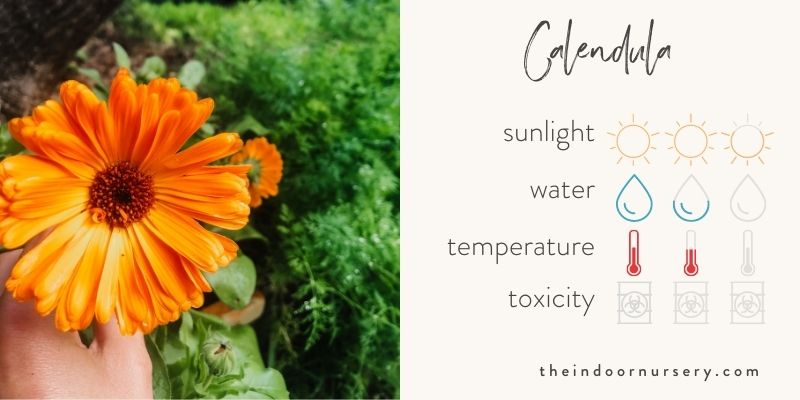
Calendula light requirements ☀️
Best light: Full sun
In its natural climate, Calendula grows across fields, where it gets lots of direct sunlight. It is known to tolerate partial shade and indirect light as well, but generally, the more light, the better. As an indoor plant, it should be kept near windows, in sunny rooms, and in greenhouses to maintain their ideal bright climate conditions year-round.
Calendula water requirements 💧
Water needs: about an inch and a half of water over a week, watering once or twice a week, or when the soil is dry
Calendula has a dense system of fibrous roots, helping it retain water in the topsoil when outdoors. A cool-season plant from a temperate region, it’s used to a moderate amount of rain and doesn’t like too-dry conditions. At the same time, it prefers well-drained, loamy soil. When you grow Calendula in the right soil, it will require only occasional watering. Calendula has easy-to-satisfy watering requirements: once or twice a week, when the soil is dry. You can use a moisture meter to keep an eye on soil moisture levels.
Calendula humidity requirements
Calendula, despite being a wet-season plant, doesn’t do well in too much humidity. When it gets hot and humid in the summer, plants outside tend to recoil for the season. The plant can handle frost, but won’t do well once it starts snowing. If the plant stays particularly damp, it might cause a problem with mold or mildew. A hygrometer will help you keep an eye on relative humidity levels.
Calendula temperature requirements
This cool-season flower tolerates the lower temperatures of spring and fall, but it’s happiest at about 70 degrees Fahrenheit. In temperate regions, the plant grows best in the transitional seasons, but slows down in the summer and winter. In warmer regions where winters don’t freeze, Calendula can grow throughout the year. Since the plant prefers the same ambient temperature we do, it’s comfortable in our home and acts as a short-lived perennial.
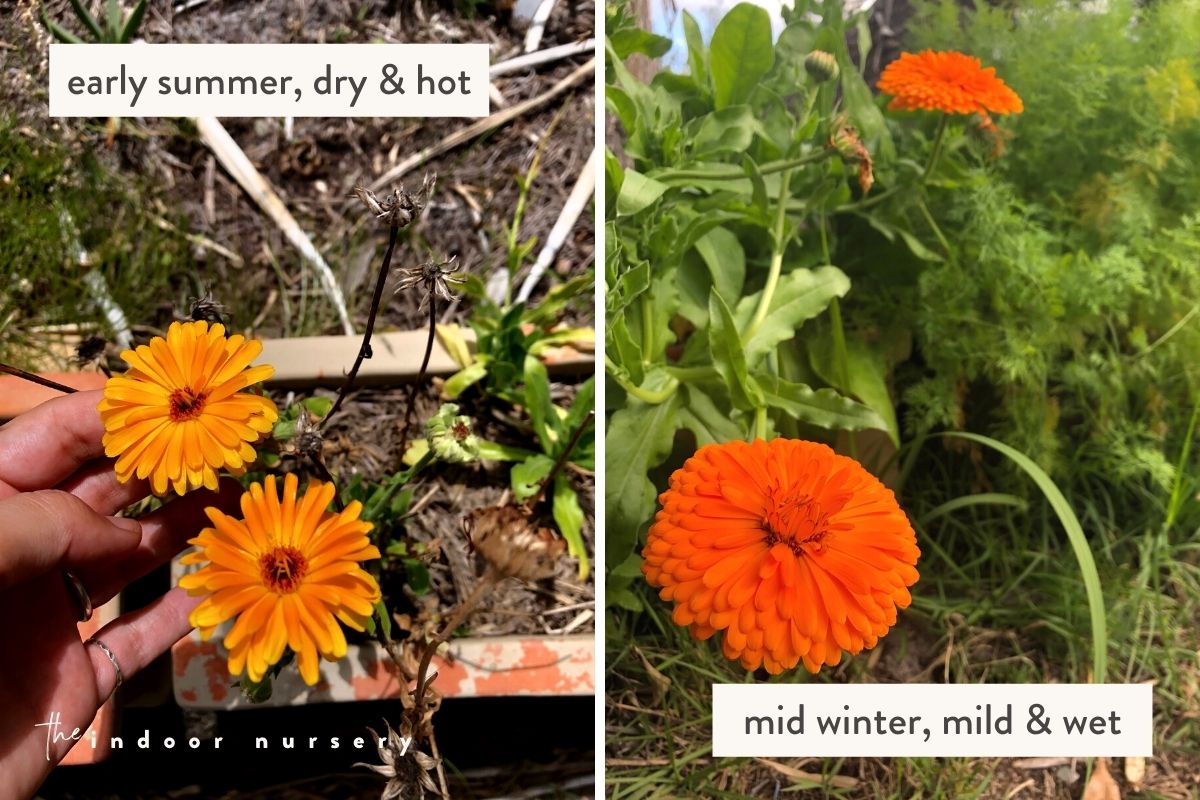
Calendula fertilizer requirements 💩
Calendula plants are relatively low-maintenance when it comes to fertilization. They thrive in moderately fertile soil, so there’s no need for heavy feeding. However, a light application of a balanced, all-purpose fertilizer in the early growing season can give them a healthy boost. Remember, over-fertilizing can lead to lush foliage but fewer blooms, so it’s best to keep it minimal.
Calendula soil requirements
Soil Type: Loamy, well-draining mix of sand, soil, clay
pH level: Neutral (6-7)
As mentioned, Calendula loves well-drained soil that holds moisture. Keeping the soil on the dryer side with a low-maintenance watering schedule is best to not overwater the plant. Loamy soil has clay and sand in addition to other organic matter that keeps the soil moist enough for the plant to get water, but dry enough that it isn’t saturated. Calendula likes soil that’s neutral or very slightly acidic: a pH of 6 to 7.
How to repot calendula
Calendula grows as individual sprouts from seeds, making them easy to transfer from a pot to pot over time, or to transplant one from the ground into a pot. Make sure the new pot drains well and the soil conditions are right. Calendula will quickly adapt to a new pot, and will do best in one that isn’t too shallow to be sure the roots aren’t in any standing water. Calendula make very sturdy seedlings, so repotting young plants is a fairly simple and safe process.
Propagating calendula
Unlike vines and other kinds of houseplants, calendula can’t be propagated by clipping. However, as an annual flower, it produces seeds that you can collect and use to plant new Calendulas. They have small, curved seeds that look like they’re folding over onto themselves. They are a little larger than other seeds in comparison making it extremely easy to sow seeds. You can plant seeds in regular or organic potting soil, and they typically take up to two months to grow from seed to mature plants.
Pruning calendula plants
Calendula plants benefit from some pruning from time to time. As the plant grows, the flower heads can be clipped when they begin to wilt, unless you’d like to keep the Calendula seeds, in which case you should allow them to dry out, but not so much that they drop the seeds. Pruning the flower heads makes space and allows light for other calendula blossoms to bloom. This is good news if you want to use the plant for food or for treatment since regular removal of the Calendula flowers encourages more to grow and provides a regular supply of petals and leaves.
Common pests / disease
When Calendula plants are outside, they’re treasured for their attractiveness to bees and butterflies, and they are often planted in vegetable gardens to redirect certain insects away from the food plants: aphids, ladybugs, and whiteflies enjoy the calendula petal’s oil. If your plant is indoors and you notice these pests, you can treat the plant with neem oil or another non-toxic insecticide.
Calendula care tips
- Clip the Calendula flowers frequently – When you cut back the flowers, it doesn’t harm the plant, rather it helps it grow in strong. A robust plant is better able to deal with stress like underwatering or temperature fluctuations.
- Put your Calendula outside when you can – This plant loves sunlight, like its Family relatives, the Daisy and Sunflower. Setting the pot outside in the open air and sunlight from time to time will be good for it, as they love good air circulation. This is also a good opportunity to give the soil a little extra soaking and let it drain out of the pot.
- Be careful not to overwater – When you water regularly indoors, make sure there isn’t any standing water in the pot. Using a deeper pot will give the soil plenty of room to sink and keep the roots dry. Too much watch can cause root rot, mold, powdery mildew, or cause the plant to wilt.
Common problems / FAQs
Why aren’t my Calendula seeds sprouting?
Calendula seeds should be planted about a quarter inch deep into the soil. Although the flowers love sunlight, the seeds don’t need it yet to germinate. Sunlight can actually hinder Calendula seeds from sprouting, so they shouldn’t be planted too shallow. The soil should be kept moist to encourage germination, and needs regular water to be sure the seed can grow during this critical period.
Why does my Calendula look weak?
Since the plant likes a well-drained soil, one of the most common reasons the Calendula might be having a problem in a pot is from too-wet soil. You may be watering too frequently, the pot may be too small, or the soil in the pot might be too compact. Use a pot that has drainage holes in the bottom. In addition, make sure that the plant is getting enough light and nutrients. While growing calendula is fairly easy to do, it’s important to get the conditions right before it will ever produce the yellow and orange flowers we know and love.
How do I make tea from Calendula flowers?
Snip off some flower heads when they are bright orange and in full bloom. Remove the petals and lay them out to dry over a day or two, flipping them periodically so they dry thoroughly. Once the leaves are crisp, you can add one to two teaspoons to boiling water and let it steep for 10 to 15 minutes.
sources
Analysis of Carotenoid Composition in Petals of Calendula (Calendula officinalis L.)
Shop our recommendations
- The Best Hydroponic Tower For Indoor Gardening
- 10 Best Worm Composter Bins For Easy Homemade Compost
- The Best pH Meter For Soil
- The 6 Best Dehumidifiers For Grow Tents
- The Best Complete Indoor Hydroponic Grow System
- 5 Best Grow Light Strips For Indoor Plants
- TESTED: Aerogarden vs Click and Grow Smart Garden
- Our *hands on* MARS HYDRO TSW 2000 review (with photos)
- 7 Best Hygrometers For Indoor Plants
- The Best Coco Coir For Your Plant’s Healthiest Root System Ever

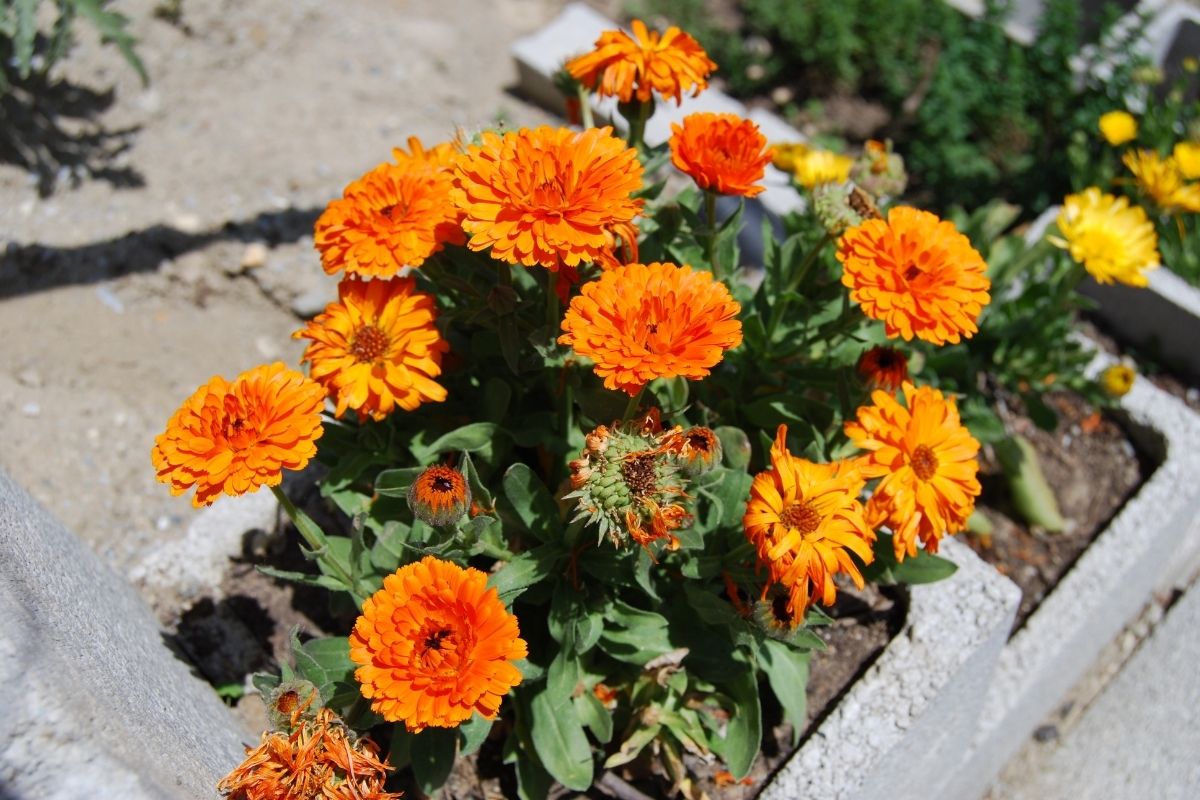
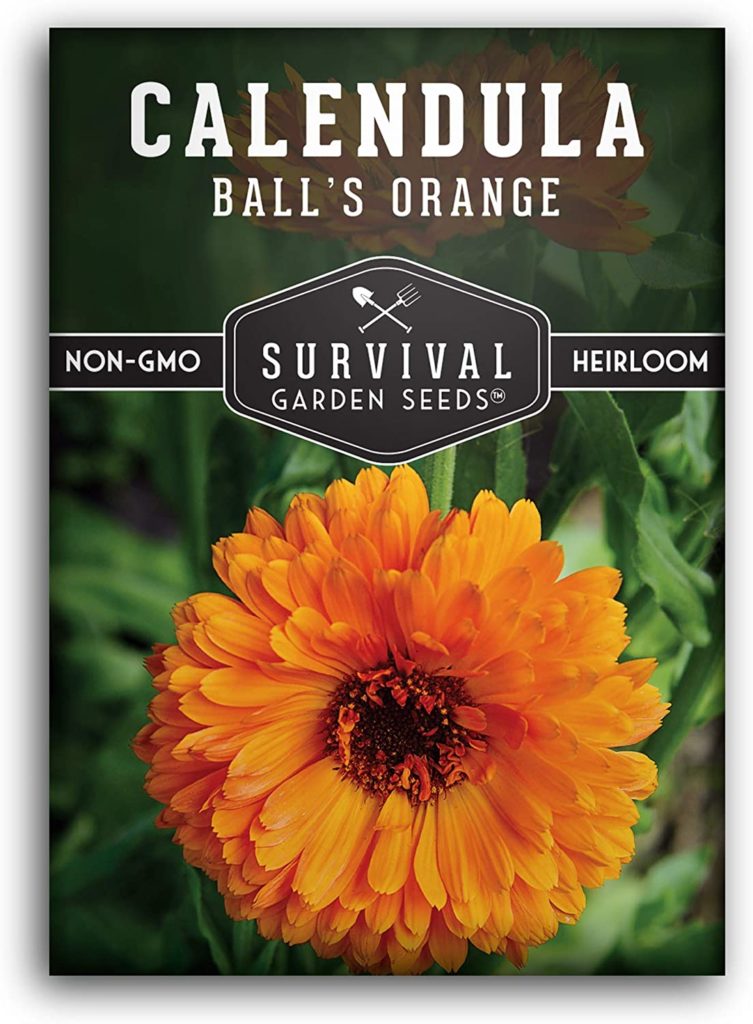


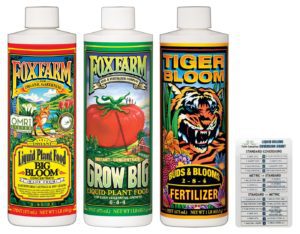




Hey, Marcia! Thanks for reading :) gosh, that's a great idea to double up on your watering globe and spike.…